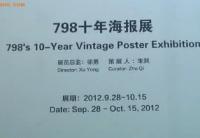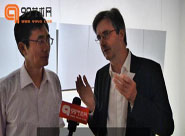Exiled in Heaven
——Thoughts of He Gong’s Recent Oil Paintings
I was deeply impressed by He Gong’s installation show Trap Designed For Future Archaeology.
When I first saw it around the turning of 1990 to 1991. To my knowledge this was probably one of the few artworks daring to confront the tragedy of 1989. Admittedly at that time He Gong was immersed by the political tragedy happened not long ago, yet after 20 years, I can still see the same humanistic care well-kept in his works. Just as most of the people seemed have forgotten that history, at least capital-driven Chinese contemporary art had turned blind eyes to past sorrow in the last decade, He Gong kept pouring his suffering and sadness into his works, with ever growing depth and complexity, and covering extensive topics.
Past 20 years had seen grand narrative criticized and deserted by post-modernism. Artistic narration had come to its end, while evasive teasing and irony dominated our age. We do not deny the critical power of irony, but the price paid was the gradual lost of courage and independence of contemporary Intellectuals. Sophistication and slickness, sons of irony, they can worm their way strategically among capital and political systems. Though He Gong’s works did not lack in irony, they were still mainly about grand narrative.
My heart was ignited by excitement when I saw He Gong’s recent oil paintings. Strength and Sincerity simply burst out of these woks. I felt a great sorrow, a sorrow rooted in our nation and our land. It was nurtured by rational reflection, lament of destiny, and criticism of society. The tragic sadness it bore came from the painter’s determination not to be parted from this nation and country. Being part of the nation’s destiny, He Gong was able to feel deeply the nation and its people’s fluctuating emotions, and witness all the changing drama staged on this land. He Gong’s paintings were all about grand topics. We found in them religion, globalization, confrontation between material and spirit, and cultural conflicts. Grandness is getting farther and farther away from us, but it does not mean we don’t need it. I saw responsibility and loneliness from He Gong’s paintings. Painting is his homeland, his Eden. His spirit roams in it, contemplates in it, and yells and screams from it. His strokes criticized sinful human nature, called for democracy and freedom. Standing in front his painting I can feel every vibration coming from his inside.
I read He Gong’s Contradiction from his paintings of sorrow– one side was his deep concern for the realistic world, yet on the other side he kept on exiling himself from reality in search of his spiritual homeland. I suspected his heart was lonely in this heavenly golden age of mundane people. He examined this “productive” world with caution and suspicion, but he casted no indifferent looks at the people in it, instead he embraced them with true loving heart. This naivety we only find in real thinker or wise’s heart. I actually had noticed this rare quality from He Gong’s oil painting The Story of Flowers Raiser during eighties. I was an editor of an art magazine then. That painting won prize in “International Young Artists Exhibition” in 1985, and got published in my magazine. It was exactly the contradiction between care for this world and self-exile that forged an intellectual’s conscience. Somehow it was like the couplet written by Master Hong Yi for Kaiyuan Temple of Quanzhou City: Ancient place bathing in Buddhism, living saint walking on streets. However, Master Hong Yi might not think himself as a saint.
Fairy tale of heavenly golden age needs commoners’ participation. This heaven at the beginning of 21st century comes not only from the public, but also the developed productivity. He Gong’s The Ambition presented the structure of organ, even more the productivity itself. Productivity was given birth by dream. He Gong wrote: one heart one dream, one more heart one more dream. This reminded us of the dream of the Great Leap Forward: The more we dare, the more the land will yield. Truth is, be it the dream of communism or the dream of globalization in 20th and 21st century, they all come down to the simple dream of productivity. Utopian imagination and the industrial mass production share the same standards of maximizing population and terrain. By the means of expanded reproduction, the goal of unlimited value-adding is achieved. Modern productivity drives people to the path of numbness, obedience, greed, and vulgarization. Human beings become alike just as their products do. Chinese people experienced two types of craziness for production in one century: one ideological, the other physical. The two together formed our crazy reality. But we rarely trace the zest back to its origin of power. We only care about the infectious effects and the songs from heaven. Where is the ideal and rationality of every individual still possessing a brain? This may be exactly what He Gong revealed to us with his brushes and images.
I found original sin theory in his Stepping Accompanied By Singing, and communism dream in The Abandoned Workshop and Grand Dinner. In The Last Dinner I saw value of religion. It was its first sorrow that made religion valuable, not its popularity with masses after its wide spread. The truth lies with the former one.
He Gong is a master of forging concepts, images and texture into one visual whole. The three come together so smoothly that wording, imaging and stroke movements all unite in some sort of self-expressing lines. However sensitive and expressive these lines are, they do not exist for sentimental flattering, but merely to carve deeper and heavier. Not the carving of realistic body, it carves further beyond words or images. This hidden meaning is not painted by careless simple lines, instead they are heavily piled-up lines with layers. They remind me of Jimo technique of water-ink painting of Gong Xian, the intellectual painter of Qing dynasty, and also oil painting texture of Kiefer. Jimo and texture both exceed limits of physical and visual world to be the records of singing soul.
Gao Minglu
May 31, 2010
【编辑:小红】

